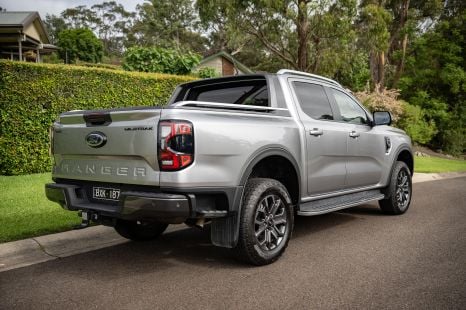

Max Davies
The Isuzu D-Max has been around since 2002 and in third-generation guise became Australia's third most popular new model in 2023. Justifiably popular among commercial and private buyers alike due to its durability and broad range of variants, the D-Max was originally sold in Australia as the Holden Rodeo between 2003 and 2008, when the facelifted version was renamed the Colorado and the D-Max itself was released by Isuzu UTE Australia. The first D-Max was replaced by the RT-series in 2012 and then the latest RG model in 2020.
| Variant | Price From* | Price To* |
|---|---|---|
| SX (4x2) HIGH-RIDE | $40,700 | $42,700 |
| SX (4x4) | $48,700 | $50,700 |
| LS-M (4x4) | $53,800 | $53,800 |
| LS-U (4x4) | $59,500 | $59,500 |
| Variant | Price From* | Price To* |
|---|---|---|
| SX (4x2) HIGH-RIDE | $32,200 | $36,200 |
| SX (4x4) | $42,200 | $44,200 |
| Variant | Price From* | Price To* |
|---|---|---|
| LS-U (4x4) | $58,000 | $58,000 |
| Variant | Price From* | Price To* |
|---|---|---|
| SX (4x2) HIGH-RIDE | $42,200 | $44,200 |
| SX (4x4) | $50,200 | $52,200 |
| LS-U (4x2) HIGH-RIDE | $53,000 | $53,000 |
| LS-M (4x4) | $55,300 | $55,300 |
| X-RIDER (4x4) | $58,000 | $58,000 |
| LS-U (4x4) | $61,000 | $61,000 |
| LS-U+ (4x4) | $63,500 | $63,500 |
| X-TERRAIN (4x4) | $67,500 | $67,500 |
| BLADE | $76,300 | $76,300 |
| Variant | Price From* | Price To* |
|---|---|---|
| SX (4x2) HIGH-RIDE | $39,700 | $39,700 |
| SX (4x4) | $47,700 | $47,700 |
See our comprehensive details for the Isuzu D-Max
The dimensions shown above are for the base model.
See all 2024 Isuzu D-Max DimensionsThe dual-cab Isuzu D-Max has a tub that measures 1570mm long, 1530mm wide and 490mm tall. There's 1122mm between the two rear wheel arches.
CarExpert High Resolution Photos of the Isuzu D-Max
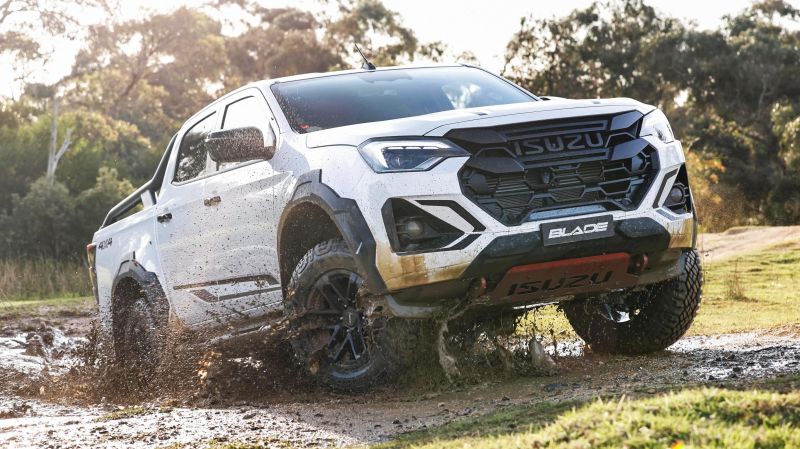
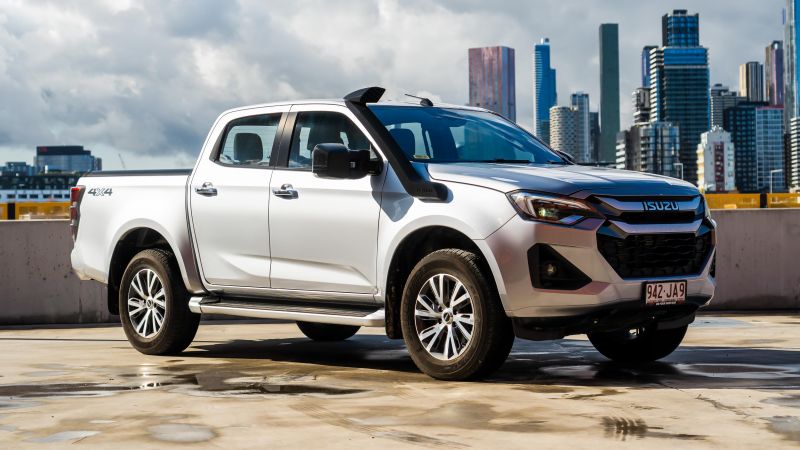
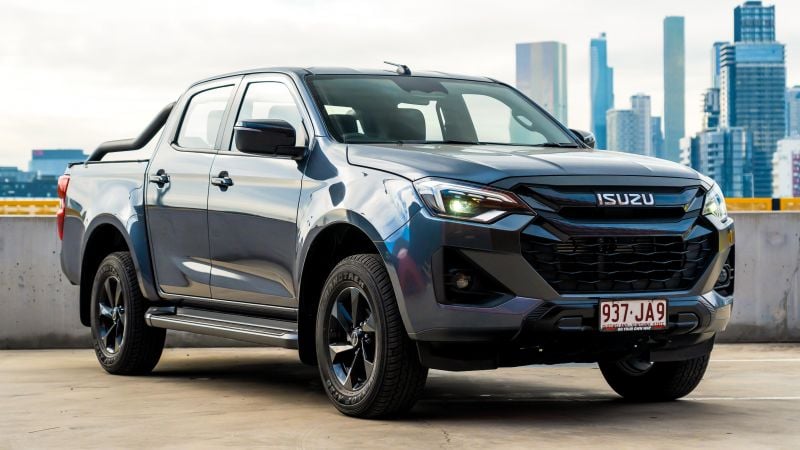

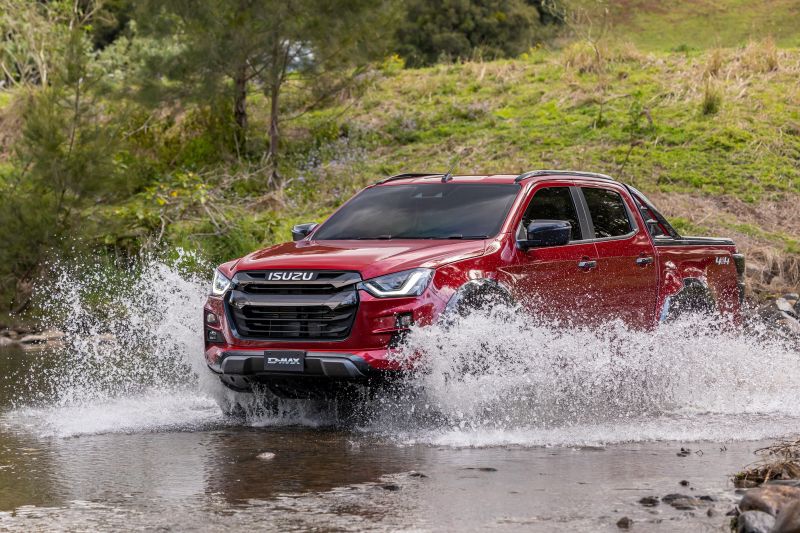



View 50 images
The Isuzu D-Max was tested by ANCAP in 2020 and earned a five-star rating.
That rating was based on an adult occupant protection score of 83 per cent, a child occupant protection score of 89 per cent and a safety assist score of 81 per cent. Vulnerable road user protection testing yielded a score of 69 per cent.
Every model comes standard with the following safety features:
Automatic models also add wrong-pedal acceleration warning, adaptive cruise, and lane-keep assist.
Eight airbags are standard, including a central airbag designed to stop the passenger and driver’s flailing arms and heads crashing into each other in a serious side-impact crash.
Combined fuel economy of the 3.0-litre D-Max ranges between 7.7L and 8.0L/100km depending on the variant, while the 1.9-litre uses between 6.7L and 7.0L/100km.
It has a 76L fuel tank across the entire D-Max range.
| Isuzu D-Max | Fuel Type | Combined |
|---|---|---|
| LS-M (4x4) | Diesel | 8.0 L/100km |
| LS-U (4x4) | Diesel | 8.0 L/100km |
| SX (4x2) HIGH-RIDE | Diesel | 7.0 L/100km |
| SX (4x4) | Diesel | 8.0 L/100km |
What are the running and servicing costs of a Isuzu D-Max?
The Isuzu D-Max has a recommended service interval of 12 months or 15,000 km, whichever comes first.
Our expert take on Isuzu D-Max drivability.
For 2024, the mid-spec LS-M Crew Cab Ute, as well as the X-Rider, have also received a softer and more compliant three-leaf standard-duty rear suspension setup. The LS-M Crew Cab Chassis still sticks with the three-leaf heavy-duty rear suspension setup however.
Another major feature D-Max 4×4 models pick up for 2024 is Rough Terrain Mode, which is an electronic off-road traction control aid that first debuted in the current-gen MU-X in 2021.
Unlike the system in the MU-X, however, the D-Max’s Rough Terrain Mode is able to work with the rear differential locked, maximising traction.
Other tweaks the 2024 Isuzu D-Max range has received includes revised tyre pressure monitoring (LS-U and up), new ‘Gen4’ stereo camera, adaptive cruise control with stop and go across the entire range, updated lane-keep assist, welcome headlight and welcome light functions, as well as a revised reversing camera that’s now fitted to cab-chassis models and has a wider field of view.
The rear cross-traffic alert system has been replaced by a more sophisticated rear cross-traffic assist feature, which will apply the brakes if it detects you’re about to have a collision while reversing.
The 2024 Isuzu D-Max is offered with a choice of two turbo-diesel four-cylinder engines: a 1.9-litre with 110kW of power and 350Nm of torque, and a 3.0-litre with 140kW and 450Nm.
Both are mated with a six-speed manual or six-speed automatic transmission with drive sent either to the rear wheels only or through a part-time four-wheel drive system with a two-speed transfer case.
The latter offers switchable 2H, 4H and 4L options plus a standard locking rear differential.
For 2024, 4×4 models also gain Rough Terrain Mode which first debuted in the current-gen MU-X but in the D-Max can be operated in tandem with the rear diff lock.
With the 3.0-litre four-cylinder turbo-diesel engine, the D-Max is torquey and tractable. It pairs wonderfully with the six-speed auto, which ably keeps it in its torque band and shifts smoothly.
There’s also a lack of turbo lag, while peak torque comes on tap at just 1600rpm and sticks around until 2600rpm.
There’s the typically gruff diesel ute soundtrack under acceleration, but at cruising speeds it’s pleasant. Wind and road noise are kept largely in check, even at highway speeds.
The electrically-assisted steering is pleasantly light and car-like without feeling vague. It’s a boon in tighter urban confines, and the D-Max feels more manoeuvrable than rivals with hydraulic set-ups. The steering also feels secure even as speeds increase.
The D-Max’s ride quality is among the best in the segment, with the usual ladder-frame ute jiggles kept to a minimum even with an empty tub. Those jiggles are further quelled when you put even a small load back there.
At high speeds on unsealed roads, the D-Max has a comfortable, sure-footed ride, even with an empty tub.
The blind-spot monitoring works well and is absolutely welcome, particularly in a segment where this feature remains rare.
The lane-keep assist isn’t too obtrusive, while the adaptive cruise control also performs admirably. You can also adjust the sensitivity of some of these systems, including the forward collision warning.
What’s most impressive about the D-Max is that the steering, ride quality and noise levels don’t get noticeably worse as your speeds get higher, meaning this is a comfortable highway cruiser.
Overall, the capable powertrain, light steering and mostly well-behaved ride makes this one of the better utes to drive.
Options list for the Isuzu D-Max
You can find more details on all the options and inclusions across the Isuzu D-Max variants on the official website, and within the official Isuzu D-Max specifications page.
What colours are available for the Isuzu D-Max
A new Sunshine Orange mica exterior paint colour is offered exclusively on the X-Terrain following the discontinuation of Volcanic Amber metallic.
The 2024 D-Max range will be offered in nine colours. All except Mineral White come at a $500 premium.
The D-Max is backed by a six-year, 150,000km warranty, and comes with seven years of roadside assist.
The D-Max's most direct competitor is the Mazda BT-50 which shares the same engine and platform.
It does compete though in the hotly-contested 4x2 and 4x4 ute segments where it goes up against the Toyota HiLux, Ford Ranger, Mitsubishi Triton, Nissan Navara, GWM Ute, Ssangyong Musso and LDV T60 Max.
Isuzu is currently pricing its D-Max in the same pricing tier as the HiLux and Ranger, though it's arguably better value than either.
Is this the right car for you? Out experts buy or not guide.
The D-Max remains one of the best workhorses in its class, and deserves its newfound popularity across the market, even if those price hikes strike me as cheeky at best.
That said, once there are plenty of V6 diesel, full-time-AWD-toting Rangers hitting the road this year with their oversized portrait touchscreens, the D-Max might feel in need of a larger-scale facelift before long.
2024 Isuzu D-Max Height
4x2 High-Ride
4x4+
The Isuzu 4JJ3-TCX engine is what powers the majority of the Isuzu D-Max range.
The Isuzu RZ4E-TC engine is what powers the entry models of the Isuzu D-Max range.
2023 Isuzu D-Max Gross Combination Mass (GCM) (KG)
4x2 High-Ride
4x4+
Maximum tow ball download (when fitted with genuine Isuzu UTE tow kit)
280kg for 1.9-litre engine models, 350kg for all other variants.
The length of the tray to the top for the applicable models is 1495mm.
The length of the tray to the floor is as follows:
4x2 High-Ride
4x4+
measurements apply to the genuine accessory alloy tray body
Turning circle diameter between kerbs for all Isuzu D-Max models is 12.5m
2024 Isuzu D-Max Approach Angle
4x2 High-Ride
4x4+
2024 Isuzu D-Max Departure Angle
4x2 High-Ride
4x4+
2024 Isuzu D-Max Ramp-over angle?
4x2 High-Ride
4x4+
All variants measure 890mm for the front overhang except the Crew Cab Ute X-Terrain which is 905mm.
2024 Isuzu D-Max Rear Overhang
4x2 High-Ride
4x4+
All 4x2 D-Max models have a GVM of 3000kg
All 4x4 D-Max models have a GVM of 3100kg
The maximum width of the Isuzu D-Max tray is:
4x2 High-Ride
4x4+
measurements apply to the genuine accessory alloy tray body
The maximum width between wheel houses of the new D-Max tray is 1122mm
490mm
There are five different tray styles for the Isuzu D-Max.
2024 Isuzu D-Max Ground Clearance
4x2 High-Ride
4x4+
The Kerb weight of the Isuzu D-Max:
4x2 High-Ride
4x4+
Kerb weight - unladen mass of vehicle plus a full tank of fuel, not including the tray body for cab chassis vehicles
There are two different engines with two different transmissions (six speed manual and six speed automatic). All ratios are listed below. The main difference between the automatic gear ratios in the 1.9L vs the 3.0L engine is the final drive ratio.
The 3.0L engine the gear ratios are as follows:
3.0L Engine: Isuzu MVL-6S 6-speed manual with high torque capacity and output reduction, 275mm diameter clutch plate and dual mass flywheel
Six-speed automatic : Aisin AWR6B45 II 6-speed with sequential shift and brake shift lock electronically controlled, tri-mode with fuel-saving lock-up torque converter on gears 3, 4, 5 and 6
The 1.9L engine the gear ratios are as follows:
Isuzu MVL-6Y 6-speed manual with high torque capacity and output reduction, 275mm diameter clutch plate and single mass flywheel
Six-speed auto in 1.9L
The best towing capacity of a Isuzu D-Max is 3500Kg offered by the following variants
The Isuzu D-Max uses diesel.